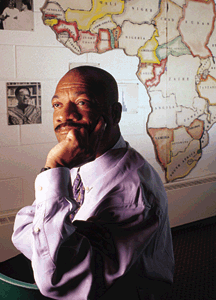Our fourth Centennial timeline: 1961-1981.
As the 196os get under way, the University is still firmly in loco parentis. The campus more or less ends at 38th Street, there is car traffic on Locust and 36th streets, and when students mention the library they mean the building designed by Frank Furness. In two turbulent decades, all those things—and much more—will change.
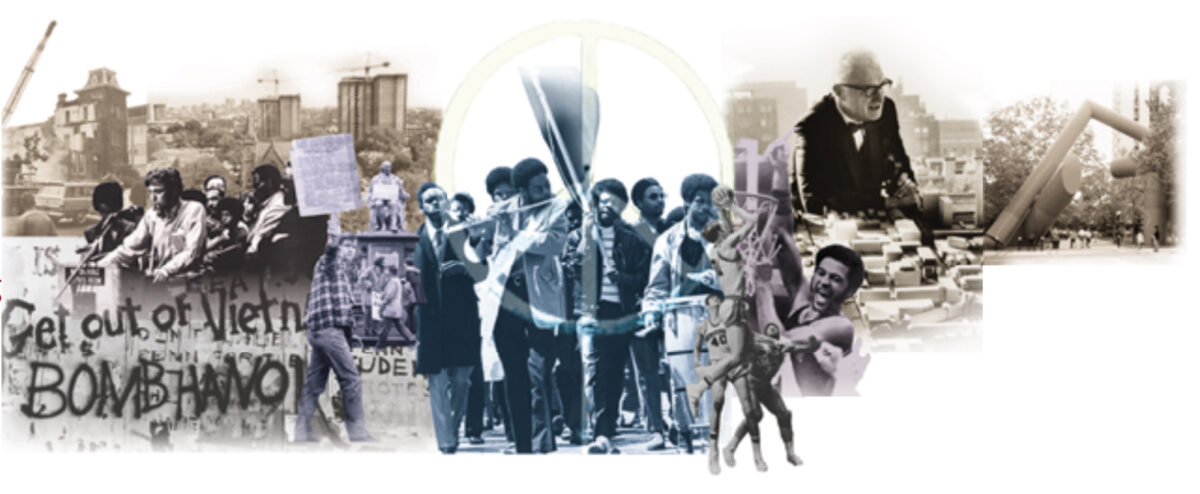
1961 | The Gazette marks the death of its first editor, George Nitzsche L’98, and the 15th anniversary of the invention of the ENIAC. A new dormitory for women, Hill Hall, opens, designed by acclaimed architect Eero Saarinen. A Gazette headline describes it as “A Starkly-Plain Outside, But a Wow! Inside.”
1962 | The Association of Alumnae celebrates its 50th anniversary. The Charles Patterson Van Pelt Library is completed. On a tour of the U.S., the Shah of Iran pays a visit to Penn, where authorities are collaborating on establishing an American-style university in Shiraz, Iran.
1963 | President John F. Kennedy is assassinated, and an editor’s note in the Gazette recalls then-Senator Kennedy speaking in Irvine Auditorium. An article on foreign students at Penn counts 1,11o from 85 countries. The College for Women marks its 3oth anniversary. The Institute of Contemporary Art is founded.
1964 | Locust Walk opens to foot-only traffic in October: “Gone are the days of the noisy trolleys, double parking, and general traffic confusion.” Anniversary celebrations include the Medical School’s bicentennial, the Philomathean Society’s 15oth anniversary, and the baseball team’s 1ooth.
1965 | The University announces a $93 million capital campaign. The men’s squash team is national champion. A group called Save Open Spaces (SOS) opposes plans for a new fine-arts building (later named Meyerson Hall), inaugurating the era of student protests at the University. In December, the Gazette publishes a letter about the first Penn alumnus killed in Vietnam.

1966 | An Afro-American Studies Program is established. College for Women senior Judith Seitz (later Rodin) is among the winners of the student Award of Merit presented by the General Alumni Society.
1967 | Barbara Berger CW’67 is the first “coed” to head Penn’s student government. A controversy over two federally sponsored biological-warfare research projects at the University, known as Spice Rack and Summit, leads to a three day sit-in at College Hall—the building’s first ever, according to the Gazette. The trustees subsequently vote to disassociate the University from the projects.
1968 | Demolition of homes and businesses for future high-rise construction in the area between 38th and 40th streets creates what the Gazette calls “Pennsylvania’s biggest hole.” New athletic director Fred Shabel proposes turning Franklin Field into a multi-purpose indoor sports complex.

1969 | In March, students occupy College Hall for six days in protest against classified military research at the University City Science Center and to demand community housing for West Philadelphia residents displaced by its construction. Gaylord Harnwell announces his retirement after 17 years as Penn’s president. A University Museum expedition uncovers Sybaris, the ancient city of pleasure. The Daily Pennsylvanian gets its first woman editor, Judy Teller CW’71, and Woodstock organizer John Roberts C’66 is profiled in the Gazette.
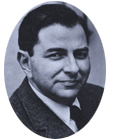
1970 | Penn’s ‘Cinderella’ basketball team earns a 25-1 record. Black students march through campus to denounce the lack of funding for black advising programs. Student walkouts and protests interrupt Commencement ceremonies. With the cry “alternate floors for 74s,” coed housing comes to the Quad. A study finds the ratio of men to women at the University is 2-to-1. Martin Meyerson Hon’70 is appointed president, and the University faces a financial crisis and looming deficits.
1971 | Anthony A. Lyle C’61 is named editor of the Gazette. The campus hangout known as the “Dirty Drug” is demolished. Harnwell House is dedicated, and a new wing of the University Museum is completed.
1972 | The University approves a black-student residence, later named W.E. B. DuBois House, after stormy debate and protests. The women’s studies program and department of computer and information science are formed. Ione A. Strauss CW’54 is elected the first woman president of the General Alumni Society. Professor of Physics J. Robert Shrieffer wins the Nobel Prize in physics.
1973 | Protests over a series of rapes in the University area lead to a three-day sit-in at College Hall and an agreement to improve security and establish a women’s center on campus. In “The new ol’ days,” a student columnist bemoans the death of 1960s-era radicalism: “The revolution was over when all the leaders went to jail or got married.”
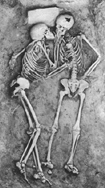
1974 | The University Museum exhibits the “Hasanlu Lovers,” a pair of entwined skeletons who died together in about 800 B.C. The Faculty of Arts and Sciences is formed out of the old College, College for Women, and Wharton School social science departments. Facing impeachment, Richard M. Nixon resigns the U.S. presidency.
1975 | Student-run radio station WXPN runs afoul of the Federal Communications Commission over obscenity complaints, in particular relating to a phone-in show called “Vegetable Report.” As part of a special “Bicentennial Beginnings” issue, the Gazette publishes the Declaration of Independence—in Esperanto. The massive “Covenant” sculpture is installed in Superblock, to decidedly mixed reviews. The $255 million Program for the 8os is formally instituted.
1976 | The Alumni Council on Admissions is established. Penn football celebrates 100 years; the 1976 team’s record is 3-6. Professor of Medicine Baruch S. Blumberg wins the Nobel Prize.
1977 | In January, the University trustees approve phasing out the School of Allied Medical Professions (SAMP) with the graduating class of 1981. A campus controversy erupts over the use by Penn’s security office of work-study students, dubbed “the Mod Squad,” to gather information on other students.
1978 | Students take over College Hall for four days to protest cuts in sports and arts programming and a tuition hike. Martin Meyerson announces he will resign as president.
1979 | The men’s basketball team advances to the Final Four in the NCAA tournament. Playboy comes to campus for a planned feature on women of the Ivy League, sparking controversy. College green is dedicated as Blanche Levy Park in October, and soon after is the site for a student protest against the seizure of Americans at the U.S. embassy in Tehran, Iran.
1980 | John Anderson is the top vote getter in a DP presidential poll of students, with Ronald Reagan a distant fourth. Tulane University President Sheldon Hackney Hon’93 is selected as Penn president. The Program for the 8os reaches its fundraising goal of $255 million. Professor of Economics Lawrence R. Klein wins the Nobel Prize in Economic Science.
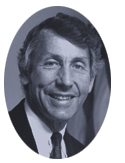
1981 | The Black Alumni Society is formed. Football coach Jerry Berndt’s revival of Penn’s football program begins inauspiciously with a 1-9 season. Sheldon Hackney is formally inaugurated as Penn president.




